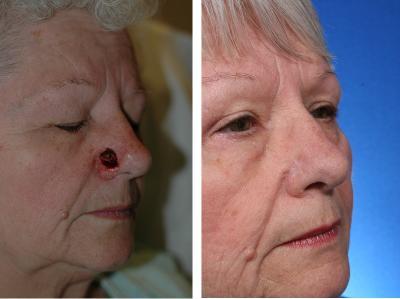Mohs surgery, developed in 1938 by Dr. Frederic E. Mohs, is the most effective technique for removing basal cell carcinoma and squamous cell carcinoma. It is a fairly common outpatient procedure.
But in a sensitive area, like in a patient with deep skin cancer and located on the nostril, the tricky part is reconstructing the nostril so that it doesn't lift up or droop down. It's an important cosmetic issue, but it's also critical for breathing.
69-year-old Carolyn Bohlmann, the patient in this instance, opted for a new reconstruction technique her surgeon, Jeffrey Moyer, M.D., was offering at the University of Michigan Comprehensive Cancer Center. Moyer removed some cartilage from behind Bohlmann's ear and skin from her shoulder and shaped it to create a new nostril in the place where the tumor had been growing.
"It healed up nicely. You can see a bit of a wrinkle, sort of a raised wrinkle. No one notices it unless I say something about having a surgery," says Bohlmann. Ten days after having the procedure done, she was back to work at the deli counter, where none of her customers said a word about her nose.
"The nose is a fairly complicated area to reconstruct," says Moyer, an associate professor of otolaryngology and the senior author on a paper that outlines this new technique.

Doctors removed a skin cancer from Carolyn Bohlmann's nostril (left). Bohlmann underwent a new reconstruction procedure that required only one operation. The cosmetic result was judged to be good to very good (right). Credit: University of Michigan
The most common method for nostril reconstruction requires taking cartilage from one part of the body and skin from the cheek or forehead to create a special skin flap. The skin flap stays in place for about three weeks so that the blood vessels can grow in the new spot. It looks very conspicuous during that time. Then patients come back to the operating room where surgeons finish the procedure by removing the flap. The tissue and blood vessels have grown over the cartilage, ensuring everything stays in place. Typical results look good and the nostril functions correctly.
But what about patients who can't – or don't want to – endure two procedures?
Moyer and his team started with one key question: Do we really need that blood supply from the skin flap? Bohlmann was one of 20 patients to take part in a clinical trial to help answer that.
The new procedure skips the skin flap – and the need for a second procedure – but still appears to allow for the cartilage to take hold and keep its place without the nostril either collapsing or pulling up. On a 1-5 scale (1 is best), the average cosmetic result was judged a 2.3 – considered to be good to very good, with minimal scarring that was not distracting to the patient's appearance. Bohlmann's result was judged as a 2.5.
"This could save people a lot of effort and time. The last thing people want to do is return to the OR," Moyer says. "It allows us to spare people multiple surgeries or a scar that dominates the cheek."
Moyer says that the cheek flap technique has a somewhat better cosmetic result than his new procedure. But since many skin cancer patients are older, they often have other medical conditions that make that second procedure unadvisable.
"The incremental benefit with a cheek flap is not worth it for some patients. The ability to do something less but still get the same quality of results is important," he says.






Comments